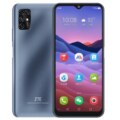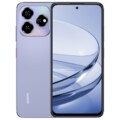- DroidAfrica
- Gadgets
- ZTE
- ZTE Blade 11 Prime
ZTE Blade 11 Prime

ZTE Blade 11 Prime Highlights and Overview
ZTE Blade 11 Prime is the latest entry-level smartphone from ZTE mobile, launched in the US in April, 2021. But this entry-level device have something not present in some flagship smartphones; wireless charging capability. The device sports a 6.52-inches screen with 720 x 1600 pixels resolution and a dew-drop notch above the screen, housing the selfie lens.
The Blade 11 Prime has three lenses on the rear, comprising of a 16-megapixel main sensor with autofocus, f/2.2 aperture and a single LED flash, a 8-megapixel wide-angle lens and a dedicated 2-megapixel depth sensor.
Under the hood, you are getting a 2.0GHz octa-core Mediatek MT6762 Helio P22 CPU, along with PowerVR GE8320 GPU, a 4GB RAM and 64GB internal storage, expandable up 256GB via external SD card.
The phone run on the latest Android 11 out of the box. It has a side mounted fingerprint scanner, support dual 4G-enabled Nano-SIMs and fueled by a 4000mAh battery out of the box with wired and wireless fast charging as well as reverse charging. The full specifications and features of ZTE Blade 11 Prime is contained in the table below.
ZTE Blade 11 Prime Full Specifications and Features
NETWORK
| Technology | GSM / HSPA / LTE |
| 2G Network Bands | GSM 850 / 900 / 1800 / 1900 - SIM 1 & SIM 2 |
| 3G Network Bands | HSDPA 850 / 1900 / 2100 |
| 4G Network Bands | LTE band 2, 4, 5, 12, 13, 66 |
| Speed | HSPA 21.1/5.76 Mbps, LTE-A Cat6 300/50 Mbps |
LAUNCH
| Also Known As |
- - |
BODY
| Dimensions | 166 x 76 x 8.7 mm |
| Weight | 190 grams |
| Build |
Glass front, - Plastic frame, - Plastic back |
| SIM Type | Dual SIM (Nano-SIM, dual stand-by) |
DISPLAY
| Display Type | IPS LCD capacitive touchscreen, 16M colors |
| Size | 6.52 inches, 102.6 cm2 (~81.4% screen-to-body ratio) |
| Resolution | 720 x 1600 pixels, 20:9 ratio (~269 ppi density) |
PLATFORM
| Operating System | Android 11 |
| Chipset | Mediatek MT6762 Helio P22 (12 nm) |
| CPU | Octa-core (2x2.0 GHz Cortex-A53 & 6x1.45 GHz Cortex A53) |
| GPU | PowerVR GE8320 |
MEMORY
| RAM + ROM | 4 GB |
| Card Slot | Yes, up to 256 GB via microSD card |
MAIN CAMERA
| Camera Type | Triple Lenses |
| Camera Sensor(s) |
Main: 16 MP, AF Ultrawide: 8 MP, f/2.2, 120˚ FoV, 16mm Depth: 2 MP, f/2.4 |
| Camera Features |
Autofocus Geotagging Panorama HDR Flash type - dual LED 5-element lens |
| Video Resolution | 1080p@30fps, |
SELFIE CAMERA
| Camera Type | Single Lens |
| Camera Sensor(s) | 8-megapixel, |
| Camera Features |
FaceID, HDR 6-level AI face Beauty f/2.2 aperture |
| Video Resolution | 1080p@30fps |
SOUND
| Loudspeaker | Yes |
| Speaker Location | Chin, below display |
| Audio Jack Type | Yes, 3.5mm audio jack |
CONNECTIVITY
| Bluetooth | Bluetooth 5.1, A2DP, LE |
| NFC | |
| GPS | Yes |
| FM Radio | Yes |
BATTERY
| Battery Capacity | Non-removable Li-Ion 4000 mAh battery |
| Wireless Charging | Yes |
OTHER FEATURES
| Sensors | Fingerprint (side-mounted), accelerometer, proximity, compass |
| Box Contents | Charging Brick / USB cable |
ZTE Blade 11 Prime User Reviews and Opinions
Disclaimer Note
We CANNOT guarantee 100% accuracy for the specification table above.












